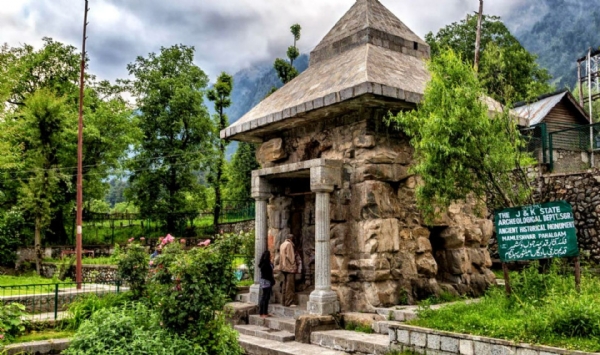Ancient Shiva temples of Kashmir that surrendered to negligence
One of the youngest Indian union territories, Jammu & Kashmir, has an overwhelming account of Hindu history and the marvelous temples that have survived over time stand witness to the glorious chapters of Indian past.
Total Views | 660
Shiva, particularly, is one of the deities that is found to have been worshiped ever since ancient times and is continued to be worshiped to date. Historically, it is observed that Shiva is worshiped in the form of ‘lingam’ in most of the regions where the rulers were either followers of or interested in Shaivism.

The earliest record of Shiva worship is found to be the Pashupatinath seal of the Indus Valley Civilization, the deity depicting many similar characteristics to Shiva. According to the archaeological excavations that have taken place until today, the Shiva lingam at Gudimallam’s (Andhra Pradesh) Parasuramesvara temple is the oldest of all, dating back to the 2nd century CE, and is worshiped even today. However, there are unpopular incidents of even older Shiva lingas excavated from ancient sites.

Shiva lingas are not restricted to temples and have been excavated at unexpected places, beyond India’s territorial bounds. The recent excavation at Vietnam where a Shiva linga dating back to the 9th century CE, can be counted as a classic example explaining the role of Shiva lingas today, in understanding the sphere of influence that Indian rulers and dynasties had established throughout the world in the early times.

While such excavations are taking place across the world, adding volumes to the position of Indian culture around the globe, there are many Shiva temples in India that have remained shadowed for a prolonged period. These temples possess great significance in understanding our own history, however, it is our own negligence that has distanced us from the knowledge of our own past. Kashmir is one such region that has remained highly unexplored.
One of the youngest Indian union territories, Jammu & Kashmir, has an overwhelming account of Hindu history, and the marvelous temples that have survived over time stand witness to the glorious chapters of the Indian past. On the account of Mahashivratri, let us head back in time to look at the ancient Shiva temples of the Kashmir valley.
1. Shankaragaurishvara Temple

Dating back to the period of Utpala dynasty, in the 8th century AD, the Shankaragaurishvara Temple, located in Baramulla’s Pattan, is a classic example of Kashmir’s marvelous temples dedicated to Shiva.
The Shiva temple was built by Shankaravarman of the Utpala dynasty (883 - 902 AD). Shankaravarman’s father Avantivarman was the founder of Utpala dynasty. Unfortunately, persistent ignorance to the grandeur of Hindu monumental heritage in the valley has left merely the ruins of the temple. The Shiva linga is not worshiped anymore, neither do we know when was the last time that happened.
The delicate and detailed work on the temple walls appears so fresh and contemporary that even the British acknowledge it in their records that the temple work is capable of easily fooling the researchers as if it belongs to the 19th century, which it doesn’t. The temple beautifully resembles the characteristics of Kashmiri architecture.
2. Sugandhesa Temple

Shankaravarman of Utpala dynasty is believed to have built two Shiva temples, in Baramulla’s Pattan. The Shankaragaurishvara temple was the first one he built among the two. The second shiva temple that he built, was in remembrance of his dear wife, Sugandha, after her demise. Both Shankaragaurishvara and Sugandhesa temples were built on the same plan, however, Sugandhesa is comparatively smaller in size than the first.
Kalhana’s Rajatrangini, which is considered as a credible Sanskrit literary source of Kashmir’s history, mentions about the Utpala dynasty and Shankaravarman’s two Shiva temples. In fact, present-day Pattan in Baramulla, was the capital city of Shakaravarman that he had founded and had named it Shankarapattan. Both the temples, however, remain in ruins today. According to The Journal of Asian Studies (2018), natural disasters stand responsible for the ruined temples. As per the Journal, Kalhana mentions Kashmir being subject to severe famines much often and the same are assumed to have caused the loss.
3. Pandrethan Temple

Hidden in today’s military establishments, stands proudly the Meruvardhanaswami temple of Pandrethan. The temple dates back to the early 12th century CE. Situated on the bank of river Jhelum, the ancient shiva temple was built by Meru, who was a minister of King Partha, hence the name ‘Meruvardhanaswami’. The period of King Partha of the Utpala dynasty, as the ruler roughly spans between 921 - 931 CE.
The town of Pandrethan shares historic significance. Kalhana’s Rajatrangini mentions Pravarsena as the King of Kashmir. He is believed to have founded the town of Pandrethan, which was the older capital of Kashmir. Derived from ‘Puranadishthan’, Pandrethan refers to the meaning ‘old city / town.’
“Earthquakes in Kashmir in early historic times are known only from fragmentary archival sources. We present and analyze unique, repeat photographs of the Pandrethan temple near Srinagar, which we conclude can provide clues to the severity of the 19th century earthquakes…Pandethran has not experienced EMS intensity greater than VIII in the past 200 year and possibly not in the past millennium.”
4. Mammal Temple

There are several such marvelous temples, especially ancient Shiva temples, all around Jammu & Kashmir, many of them even in ruins but still provide holy abode for the shiva linga. However, may it be any religion or dharma, the sole purpose of any place of worship is the gathering of pilgrims. A temple has no meaning in absence of the pilgrims. Pilgrims are as important for the survival of the temple as much is the presence of God, in the form of an idol. However, it is our negligence to this heritage and legacy from the past that has stolen the liveliness of these temples. These temples await the touch of devotion and the urge of exploring and learning to revitalize them.

The earliest record of Shiva worship is found to be the Pashupatinath seal of the Indus Valley Civilization, the deity depicting many similar characteristics to Shiva. According to the archaeological excavations that have taken place until today, the Shiva lingam at Gudimallam’s (Andhra Pradesh) Parasuramesvara temple is the oldest of all, dating back to the 2nd century CE, and is worshiped even today. However, there are unpopular incidents of even older Shiva lingas excavated from ancient sites.

Shiva lingas are not restricted to temples and have been excavated at unexpected places, beyond India’s territorial bounds. The recent excavation at Vietnam where a Shiva linga dating back to the 9th century CE, can be counted as a classic example explaining the role of Shiva lingas today, in understanding the sphere of influence that Indian rulers and dynasties had established throughout the world in the early times.

While such excavations are taking place across the world, adding volumes to the position of Indian culture around the globe, there are many Shiva temples in India that have remained shadowed for a prolonged period. These temples possess great significance in understanding our own history, however, it is our own negligence that has distanced us from the knowledge of our own past. Kashmir is one such region that has remained highly unexplored.
One of the youngest Indian union territories, Jammu & Kashmir, has an overwhelming account of Hindu history, and the marvelous temples that have survived over time stand witness to the glorious chapters of the Indian past. On the account of Mahashivratri, let us head back in time to look at the ancient Shiva temples of the Kashmir valley.
1. Shankaragaurishvara Temple

Dating back to the period of Utpala dynasty, in the 8th century AD, the Shankaragaurishvara Temple, located in Baramulla’s Pattan, is a classic example of Kashmir’s marvelous temples dedicated to Shiva.
The Shiva temple was built by Shankaravarman of the Utpala dynasty (883 - 902 AD). Shankaravarman’s father Avantivarman was the founder of Utpala dynasty. Unfortunately, persistent ignorance to the grandeur of Hindu monumental heritage in the valley has left merely the ruins of the temple. The Shiva linga is not worshiped anymore, neither do we know when was the last time that happened.
The delicate and detailed work on the temple walls appears so fresh and contemporary that even the British acknowledge it in their records that the temple work is capable of easily fooling the researchers as if it belongs to the 19th century, which it doesn’t. The temple beautifully resembles the characteristics of Kashmiri architecture.
2. Sugandhesa Temple

Shankaravarman of Utpala dynasty is believed to have built two Shiva temples, in Baramulla’s Pattan. The Shankaragaurishvara temple was the first one he built among the two. The second shiva temple that he built, was in remembrance of his dear wife, Sugandha, after her demise. Both Shankaragaurishvara and Sugandhesa temples were built on the same plan, however, Sugandhesa is comparatively smaller in size than the first.
Kalhana’s Rajatrangini, which is considered as a credible Sanskrit literary source of Kashmir’s history, mentions about the Utpala dynasty and Shankaravarman’s two Shiva temples. In fact, present-day Pattan in Baramulla, was the capital city of Shakaravarman that he had founded and had named it Shankarapattan. Both the temples, however, remain in ruins today. According to The Journal of Asian Studies (2018), natural disasters stand responsible for the ruined temples. As per the Journal, Kalhana mentions Kashmir being subject to severe famines much often and the same are assumed to have caused the loss.
3. Pandrethan Temple

Hidden in today’s military establishments, stands proudly the Meruvardhanaswami temple of Pandrethan. The temple dates back to the early 12th century CE. Situated on the bank of river Jhelum, the ancient shiva temple was built by Meru, who was a minister of King Partha, hence the name ‘Meruvardhanaswami’. The period of King Partha of the Utpala dynasty, as the ruler roughly spans between 921 - 931 CE.
The town of Pandrethan shares historic significance. Kalhana’s Rajatrangini mentions Pravarsena as the King of Kashmir. He is believed to have founded the town of Pandrethan, which was the older capital of Kashmir. Derived from ‘Puranadishthan’, Pandrethan refers to the meaning ‘old city / town.’
Academically, the Meruvardhanaswami temple of Pandrethan is significant as it helps geologists understand the tectonic activities in the Himalayas. The Geological Society of America (2010) quotes on the same lines;
4. Mammal Temple

Anciently known as Mamalaka, the ruins of a small Shiva temple of sculptured stones called the Mamal temple are found in Lidder valley at Mamal on the hillside, 46 miles from Srinagar. Kalhans Rajatrangini, like other ancient temples, accounts in detail about the Mamal Shiva temple. According to the description in Rajatarangini, the shiva linga in the temple is referred to as ‘Mammeshvara’.
It is mentioned in the Indian Journal of Archaeology: Ancient Hindu Temple Architecture of South Kashmir from 7th Century A.D to 13th century A.D. that “the temple forms a cella (inner area of ancient temple) of the usual style, with a porch resting on columns. In front of it is a stone-lined spring about 12 feet square, containing limpid water.” The Journal also mentions the temple remaining safe from the destruction at the hands of Alexander (Sikandar).
According to the journal, he had, however, gone up the Lidder valley with the intention of proceeding to the cave of Amarnath and breaking the Ice-linga there and also the temple of Mamal en route. On reaching Ganeshbal, he broke the stone image of Ganesh standing in the middle of the Lambodari or Lidder River there.
Folklore describes the incident stating that, when the knee of the Ganesha image was struck by Sikandar with a hammer, a flood of blood flowed down. On witnessing this frightful spectacle, the Iconoclast got terrified and henceforth desisted from further destruction of the Hindu temples and images. He then abandoned the idea of going farther to Amarnath and returned, regretting his past sacrilegious acts and deeds.
Bharati Web








